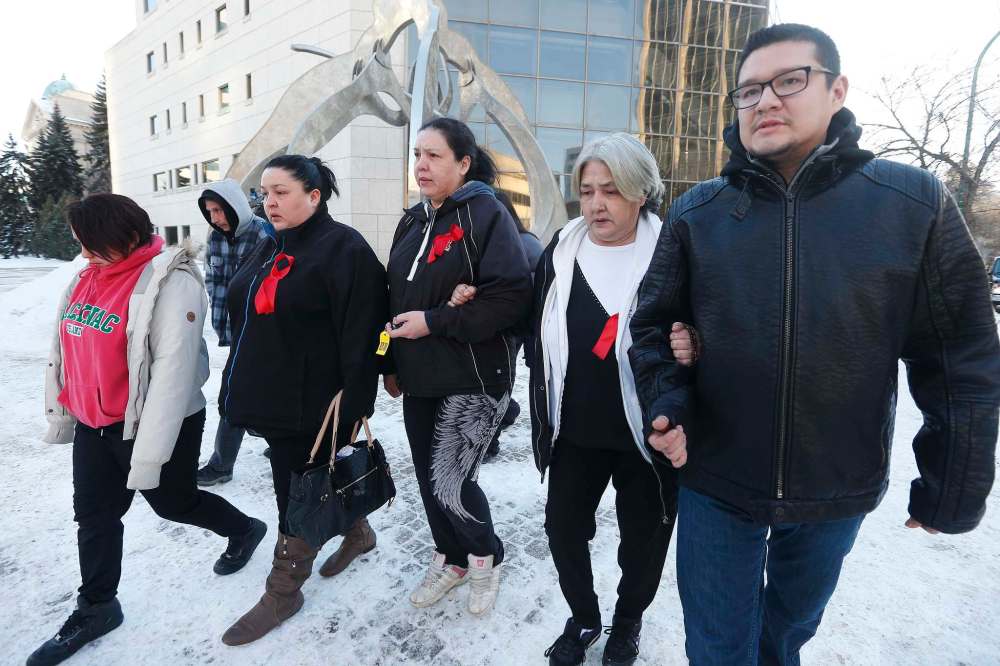Tina’s voice brings courtroom to tears
Sadness overwhelms proceedings as teen's call to 911 played
Advertisement
Read this article for free:
or
Already have an account? Log in here »
To continue reading, please subscribe:
Monthly Digital Subscription
$0 for the first 4 weeks*
- Enjoy unlimited reading on winnipegfreepress.com
- Read the E-Edition, our digital replica newspaper
- Access News Break, our award-winning app
- Play interactive puzzles
*No charge for 4 weeks then price increases to the regular rate of $19.00 plus GST every four weeks. Offer available to new and qualified returning subscribers only. Cancel any time.
Monthly Digital Subscription
$4.75/week*
- Enjoy unlimited reading on winnipegfreepress.com
- Read the E-Edition, our digital replica newspaper
- Access News Break, our award-winning app
- Play interactive puzzles
*Billed as $19 plus GST every four weeks. Cancel any time.
To continue reading, please subscribe:
Add Free Press access to your Brandon Sun subscription for only an additional
$1 for the first 4 weeks*
*Your next subscription payment will increase by $1.00 and you will be charged $16.99 plus GST for four weeks. After four weeks, your payment will increase to $23.99 plus GST every four weeks.
Read unlimited articles for free today:
or
Already have an account? Log in here »
Hey there, time traveller!
This article was published 30/01/2018 (2873 days ago), so information in it may no longer be current.
A deluge of words has already been spilled about Tina Fontaine, the 15-year-old girl from Sagkeeng First Nation who was found dead in the Red River in August 2014 and inadvertently became the poster child for a national inquiry into missing and murdered Indigenous women and girls.
On Monday, about 60 people in a Winnipeg courtroom finally heard from Tina herself.
“Hey, umm. I would like to report a blue truck that was stolen earlier today,” said a drawling, child-like voice emanating from the speaker system.

As soon as Tina’s great-aunt Thelma Favel heard the voice, she began to sob into both hands on the witness stand. Other relatives in the gallery cried, too, passing tissue boxes to and fro.
“That’s Tina,” Favel told Crown lawyer James Ross after the recording of the quick phone call, which lasted about 40 seconds.
Tina placed a 911 call Aug. 6, 2014, at 10:18 p.m., to report her friend “Sebastian” had stolen a vehicle, court heard. Within seconds, the operator told her a different number to call to reach police directly.
“’Kay then,” Tina said, sounding a bit defeated. “Bye.”
She hung up. The teen’s presence was jarring and swift — gone nearly as fast as it materialized.
Monday was the first day of a trial almost four years in the making. The accused, Raymond Joseph Cormier, 55, maintains his innocence, pleading not guilty to second-degree murder in the death of Tina.
Cormier was escorted into courtroom 230 with his hands and ankles in shackles. He sported a grey-and-black striped crewneck sweater, grey pants and white Nike shoes. His salt-and-pepper hair was cropped close to his skull, nothing like the unruly mane in his now-infamous mug shot. His beard looked as though it had been shaved the day before.
Favel, the first witness called by the Crown to testify, didn’t appear to make eye contact with Cormier throughout the daylong proceedings. She sat in the gallery’s front row, near the jurors box.
Cormier sat in the middle of the room, shielded from view. The tall wooden bench had three cocoon-like walls at least 1.5 metres tall, making the defendant only visible to the jury — eight women and four men — witnesses, lawyers, clerks and Manitoba Court of Queen’s Bench Chief Justice Glenn Joyal.
In his opening remarks, Crown attorney Ross outlined the evidence court will hear over the next several weeks (the trial is expected to wrap by March 2) and called six witnesses, alongside fellow prosecutor Breta Passler.
Ross asked Favel about Tina, whom she described as “sparkling.” She wrapped up her testimony in tears.
Tina’s mother, Tina Duck, was in court briefly Monday morning, but left within the first hour of proceedings — before Favel took the stand — and did not return.
Favel returned to her seat, resting her head on her husband Joseph Favel’s shoulder. Her facial expressions remained pained for the rest of the day.
Later, witness testimonies from police and firefighters explained where Tina’s body was found and its level of decomposition, which prevented any forensic evidence from being extracted for the case. She was found in the Red River on Aug. 17, 2014, wrapped in a tan-coloured duvet cover weighed down with rocks.
Hearing the bleak testimonies stung for relative strangers, so one can only imagine how Tina’s family was feeling. Members of the family told media no comment as they were leaving the courthouse.
Some of Tina’s family wore red ribbons pinned to their sweaters and blouses, a tribute to missing and murdered Indigenous women and girls across the country.
Ostensibly, hundreds of other families with missing or murdered loved ones are reading about Cormier’s trial, hearing about it on the radio or watching news excerpts on television, as they anxiously await their own days in court — if such circumstances ever surface.
There are the families of Cherisse Houle, Glenda Morrisseau, Hillary Wilson and Cheryl Duck, whose bodies were found, but their killers never apprehended.
There are the families of Sunshine Wood, Claudette Osborne-Tyo, Fonessa Bruyere, Sylvia Guiboche, Felicia Solomon and Jennifer Catcheway — women who vanished, leaving their relatives in a perpetual, agonizing wait to see them again.
There are far, far too many people who could be in the same scenario as Tina’s family, waiting for an iota of justice.
A month from now, we may know if Tina’s family got what they came for.
jessica.botelho@freepress.mb.ca
Twitter: @_jessbu



